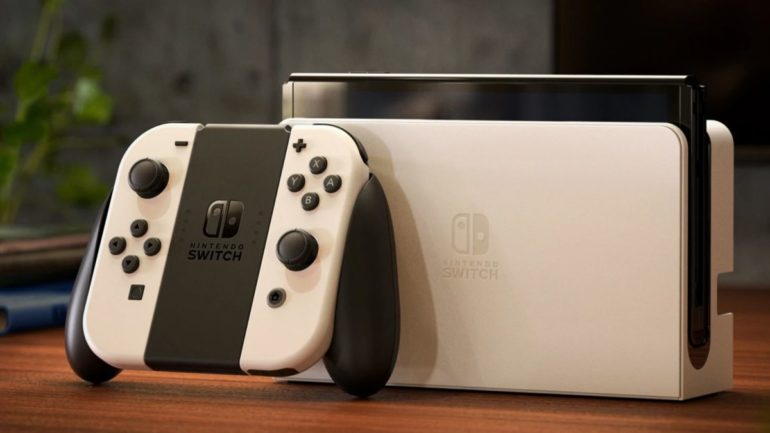After months of speculation, we finally know what Nintendo’s mid-gen refresh of the Switch looks like – and it’s called the Nintendo Switch OLED.
Nintendo made the announcement on July 6 on its official Twitter account, after many had speculated that the new console would be revealed before or during E3 2021 in June.
The specs of the Nintendo Switch OLED align with some of the rumors we’d been hearing about the updated console, and it comes with a 7-inch OLED screen, which is larger than the Switch’s 6.2-inch LCD display. Here’s everything you need to know about Nintendo’s new hybrid console.
Nintendo Switch OLED: cut to the chase
What is it? A mid-gen refresh of the Nintendo Switch with an OLED screenWhen is it out? October 8, 2021How much does it cost? $349.99 / £309.99 / AU$539
Nintendo Switch OLED release date and price
The Nintendo Switch OLED will be available on October 8, 2021, and it costs $349.99 / £309.99 / AU$539. The current Nintendo Switch costs $299.99 in the US, £279.99 in the UK, and $449 in Australia, while the Nintendo Switch Lite, which is a handheld-only device, costs $199.99 / £199.99 / AU$329.95.
It means the Nintendo Switch OLED costs $50 / £30 / AU$90 more than the standard Switch model, which isn’t a massive premium to pay for the new features on offer.
Pre-orders are now live
Pre-orders for the Nintendo Switch OLED are now live at numerous retailers. Check out our pre-order page for the US, UK and Australia, so you don’t miss out when the Switch OLED releases on October 8, 2021.
Nintendo Switch OLED features
We know that the Nintendo Switch OLED’s main appeal is its organic light emitting diode display, or OLED for short. OLED is widely regarded as one of the best display technologies around, as unlike an LCD screen, it doesn’t rely on a backlight to display images. Instead, it displays images using light emitted by each individual pixel, which means you can get perfect inky blacks and higher contrast levels.
The display size of the Nintendo Switch OLED is also larger than the original Switch’s LCD screen. It’s now 7 inches, which should give you a bit more real estate when you’re huddled over playing Mario Kart 8 Deluxe with friends, and provide some added immersion when playing The Legend of Zelda: Breath of the Wild 2 when that game eventually releases sometime in 2022.
Some surprises come in the form of a wider, adjustable stand, and enhanced audio quality; however, it doesn’t look like the Nintendo Switch OLED will support spatial audio tech like Dolby Atmos. Instead, it appears that the speakers on the unit itself have merely been upgraded for a better experience when you’re playing in handheld or tabletop mode.
The wider kick stand is more akin to something we’d find on a Microsoft Surface, and means that, when playing in tabletop mode, it’ll be much easier to find the perfect position to play.
Another new addition is wired LAN support, which will come as a relief to those who feel Nintendo Switch’s online games aren’t the most stable or reliable when played over Wi-Fi. It’ll also benefit titles like Super Smash Bros. Ultimate and Splatoon 3, the latter of which is due to release in 2022.
Thankfully, another area where the Nintendo Switch OLED improves over the original is internal storage. The Nintendo Switch OLED has 64GB of storage compared to the 32GB on the original Switch model, and there’s still support for compatible microSD cards.
The Nintendo Switch dock has also received a subtle upgrade, as it now sports rounded edges for a more modern-looking design, and comes in an off-white, which matches the new white color scheme of the Nintendo Switch OLED. The console is also available in the classic Neon Blue/Red color combo with a black dock.
Like the previous model, the new Switch dock will be available to purchase separately from the Nintendo online store (it won’t be sold at retail) and will work with the original Switch. The old dock cost $60, so we expect the new dock to be priced similarly.
Nintendo Switch OLED technical specifications
Want to know about the ins and outs of the new Nintendo Switch OLED? Check out the full breakdown of the console’s technical specifications below:
Size: 9.5 x 0.55 x 4 inches (w x d x h)Weight: Approximately 0.71 lbs / 0.93 lbs with Joy-Con controllers attachedScreen: Multi-touch capacitive touch screen / 7-inch OLED screenResolution: 1280 x 720 (720p)CPU/GPU: Nvidia Custom Tegra processorStorage: 64GB (can be expanded using microSDHC or microSDXC cards up to 2TB)Wireless: WI-Fi (802.11 a/b/g/n/ac compliant)Video output: Up to 1080p via HDMI in TV mode, 720p in handheld modeAudio output: 5.1 Linear PCMSpeakers: StereoUSB connector: USB Type-C for charging3.5mm headphone jackBattery life: approximately 4.5-9 hoursCharging time: approximately 3 hours
Is the Nintendo Switch OLED 4K?
Surprisingly, no. One of the biggest features the Nintendo Switch Pro was tipped to have was the option to output at 4K resolution when docked, but the Switch OLED will only output at 1080p, just like the regular Switch. This seems like a big missed opportunity for Nintendo, and might make the upgrade a little harder to justify for some.
It’s likely that the Nintendo Switch OLED display will stick to the 720p output of the original Switch too, as it means existing Switch software won’t have to be upgraded. This means that rumors of Nvidia DLSS support, which using AI upscaling to help games achieve 4K, is off the cards.
Targeting a resolution of 4K resolution could have also led to the console being more expensive, which is why Nintendo may have opted to stick with the original 720p output in handheld mode and 1080p when docked.
Will every Switch game work on the Switch OLED?
Can all Nintendo Switch titles be played on Nintendo Switch OLED? Absolutely. The Switch OLED is essentially a fancier Nintendo Switch, so it means means that every Switch game is compatible. However, Nintendo notes that some game experiences with the Toy-Con accessories from the Nintendo Labo series may differ due to the Switch OLED’s larger screen.
Existing Switch accessories will also work with the Nintendo Switch OLED model, according to Nintendo, but naturally things like screen protectors wouldn’t be compatible due to the Switch OLED’s larger screen.
What happened to the Nintendo Switch Pro?
The Nintendo Switch OLED is essentially the Nintendo Switch Pro that has been heavily rumored for quite some time. The technical specifications all line up with what we’ve heard previously, though the biggest outlier is the lack of 4K resolution support when docked.
The Switch OLED announcement has been met with disappointment by some who were hoping Nintendo would follow a similar strategy to Microsoft and Sony, who both released more powerful consoles in the form of the Xbox One X and PS4 Pro during the last generation. This allowed existing games to receive resolution bumps and better performance, which would admittedly be welcome for some Switch titles.
It’s unlikely, then, that Nintendo will announce another Switch model anytime soon, but an analyst believes that Switch Pro might still be in the works. We’d advise tempering your expectations, though, as a more powerful Nintendo Switch model suddenly seems a long way off.
Will OLED burn-in be a cause for concern?
One of the most common concerns regarding OLED displays is that they can be susceptible to burn-in. Burn-in is a term used to describe permanent image retention on OLED displays that can occur from looping logos or static HUDs. When elements such as these are displayed for hours at a time, it can permanently scar the panel’s pixels, leaving residual ‘ghost’ patterns that can’t be turned off.
Thankfully, OLED panel manufacturers have made great strides in negating burn-in, with LG using ‘screen shift’ technology, which subtly moves static images onscreen to ensure individual pixels aren’t outputting the same information for sustained periods of time.
But could the Nintendo Switch OLED be susceptible to burn-in? TechRadar spoke to OTI Lumionics CEO Michael Helander, who told us that “Modern OLED display panels have active compensation that will prevent the effect of burn-in. This records how much time each pixel has been turned on individually and will then in the back-end hardware adjust the output signal […] to ensure that screen output remains uniform and effect of burn-in is eliminated.”
Helander cites Nintendo’s ability to control “the UI of games launched on their platform”, allowing it to “shift UI boxes slightly during gameplay session to eliminate the issue of individual pixel burn-in”, and added that “there were not a lot of complaints in the PS Vita regarding burn-in from OLED devices 8-10 years ago […] The lifetime of OLED devices has improved at least 10x over the last 8 to 10 years, thus I don’t expect burn-in to become an issue for the Switch OLED.”
Fingers crossed, then, that burn-in doesn’t occur on the Switch OLED model.
Will Joy-Con drift be fixed on the Switch OLED?
Nintendo has confirmed that the Joy-Con controllers that ship with the Nintendo Switch OLED haven’t been updated or changed in any way. This means that the dreaded issue of Joy-Con drift could still occur, which is disappointing.
A Nintendo representative said: “The Joy-Con controller configuration and functionality did not change with the Nintendo Switch system (OLED model). The configuration and functionality is the same as that of the Joy-Con controllers for the Nintendo Switch system.”
Joy-Con drift occurs when the analog stick of either Joy-Con inputs signals even when in the neutral position. This can lead to your onscreen crosshair or character moving without any input from the user. Nintendo has faced multiple lawsuits regarding the problem, and even publicly apologized for Joy-Con drift in 2020.
It’s a shame that the Switch OLED Joy-Con controllers could exhibit the same drifting problem, especially as it’s been an ongoing concern since 2017.
Today’s best Nintendo Switch deals



